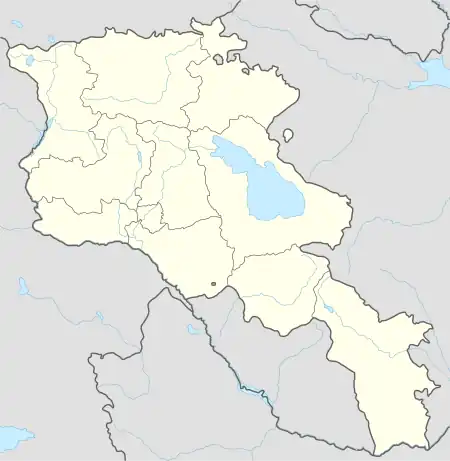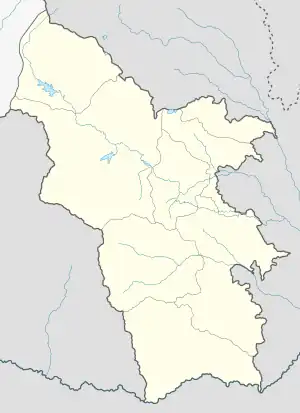Nrnadzor
Նռնաձոր | |
|---|---|
 Nrnadzor  Nrnadzor | |
| Coordinates: 38°54′57″N 46°26′32″E / 38.91583°N 46.44222°E | |
| Country | |
| Province | Syunik |
| Municipality | Meghri |
| Area | |
| • Total | 118.61 km2 (45.80 sq mi) |
| Population | |
| • Total | 148 |
| • Density | 1.2/km2 (3.2/sq mi) |
| Time zone | UTC+4 (AMT) |
Nrnadzor (Armenian: Նռնաձոր) is a village in the Meghri Municipality of the Syunik Province in Armenia, on the bank of the Aras River.
Toponymy
The village of Nrnadzor (meaning "pomegranate canyon" in Armenian, also the name of a nearby tributary of the Aras) was previously called Nyuvadi (Armenian: Նյուվադի; Azerbaijani: Nüvədi).
History
During the Russian Empire, the village was a part of the Zangezur uezd of the Elizavetpol Governorate. The village was transferred from the Azerbaijan SSR to the Armenian SSR in 1928.[3] The Azerbaijani-speaking population of the village fled in the summer of 1991 in the context of the Nagorno-Karabakh conflict, after which the village was repopulated by Armenians who fled from different parts of Azerbaijan.[3] The exact date the Azerbaijani population departed was 8 August 1991 – the local administration ensuring their peaceful departure without violence.[4] On 4 July 2006, the village was renamed to its current name.[5]
Demographics
The population is engaged with viticulture, fruit growing, animal husbandry and beekeeping.[5] At its height, the local school consisted of about 1,000 students.[4]
Sevan Nişanyan describes that the population of the village was "Turkish" until 1988, "Muslim Tat" until 1991, and adds that the local population was not of Tat origin, mentioning that the population is described as "Tatar" (later known as Azerbaijani) in Russian records since 1831.[6] Whilst Tatul Hakobyan says that the Muslims who lived in Nrnadzor were actually Tats who over time, like thousands of Tats in Soviet Azerbaijan, became Azeri. The Tats were counted and enumerated in various ways between 1831 and 1931: as Muslims, Tatars, Turko-Tatars, and a Turkish group. Russian records of 1894 describe the village's population of consisting of 1,094 Tats.[3]
After the exodus of the local Azerbaijanis, Armenian families from Gyumri, Kapan, Goris, Armavir, and Getashen (Çaykənd, Goygol) settled in the village. As of 2020, most of the population lives in former-Azerbaijani homes—the administrative head of the village, Aleksan Boyajyan, claims that the village consists of "42 households, 128 inhabitants", also mentioning that "Because of the past 15 years, many of the settlers left the village."[4]
The population of the village since 1831 is as follows:[5][3]
| Year | Population | Note |
|---|---|---|
| 1831 | 291 | 100% Muslims |
| 1873 | 705 | 100% Tatars |
| 1886 | 1,083 | 100% others |
| 1897 | 952 | 100% Muslims |
| 1904 | 771 | |
| 1914 | 1,072 | |
| 1922 | 662 | 100% Turkish-Tatars |
| 1926 | 494 | 480 Turks, 14 others |
| 1931 | 596 | 100% Turkish |
| 1939 | 618 | |
| 1959 | 761 | |
| 1970 | 1,277 | |
| 1979 | 1,539 | |
| 1989 | 1,344 | |
| 2001 | 152 | |
| 2004 | 106 | |
| 2010[7] | 140 | |
| 2011[2] | 148 |
References
- ↑ "Syunik regional e-Governance System" (in Armenian). Syunik Province provincial government. Click on link entitled "Համայնքներ" (community) and search for the place by Armenian name.
- 1 2 Statistical Committee of Armenia. "The results of the 2011 Population Census of Armenia" (PDF).
- 1 2 3 4 "Նռնաձոր գյուղի բնակչությունը 1831-1931 թվականներին. Մեղրիի շրջան" [The population of Nrnadzor village (Meghri region) from 1831–1931]. ANI Armenian Research Center (in Armenian). 13 August 2021. Retrieved 26 September 2021.
- 1 2 3 Mirzoyan, Gayane; Mkrtchyan, Gayane (6 July 2020). "Armenian village bordering Iran where Azerbaijanis used to live". JAM News. Yerevan. Retrieved 2022-09-30.
- 1 2 3 Հայաստանի Հանրապետության բնակավայրերի բառարան [Republic of Armenia settlements dictionary] (PDF) (in Armenian). Yerevan: Cadastre Committee of the Republic of Armenia. 2008. Archived from the original (PDF) on 11 March 2018.
- ↑ Nişanyan, Sevan. "Nrnadzor yerleşimleri". Index Anatolicus. Retrieved 30 September 2022.
- ↑ "Marzes of Armenia and Yerevan City in Figures, 2010" (PDF). Statistical Committee of Armenia.
